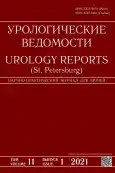Neurogenic urinary disorders in patients with tuberculous spondylitis before and after surgical treatment
- Authors: Gorbunov A.I.1, Murav’ev A.N.1,2, Sokolovich E.G.1,3, Yablonsky P.K.1,3
-
Affiliations:
- Saint Petersburg State Research Institute of Phthisiopulmonology of the Ministry of Healthcare of the Russian Federation
- Saint Petersburg Medico-Social Institute,
- Saint Petersburg State University
- Issue: Vol 11, No 1 (2021)
- Pages: 27-32
- Section: Original study articles
- Submitted: 26.11.2020
- Accepted: 09.01.2021
- Published: 27.05.2021
- URL: https://journals.eco-vector.com/uroved/article/view/52482
- DOI: https://doi.org/10.17816/uroved52482
- ID: 52482
Cite item
Abstract
ABSTRACT: Tuberculosis inflammation of vertebral column (spondylitis) can lead to neurogenic lower urinary tract dysfunction. There is lack of available publications for neurogenic lower urinary tract dysfunction in spinal tuberculosis.
OBJECTIVE: To evaluate urodynamic disturbances in spinal tuberculosis before and after surgery for spondylitis.
MATERIALS AND METHODS: We observed 19 patients with spinal tuberculosis, who had symptoms of micturition’s impairment. 14 patients (73,6%) were male and 5 (26,4%) were female, average age was 43,7 ± 7,9 years (27–66). Control evaluation was performed after surgery on day 21–28.
RESULTS: Before surgery we found detrusor overactivity in 11 (57,9%) patients and 2 of those with detrusor overactivity had detrusor-sphincter dyssynergia. Detrusor hypo-/acontractility was diagnosed in 8 (42,1%). After surgery 5 patients (26,3%) exhibited improvement, in one case urodynamic disturbances were resolved. One patient developed detrusor overactivity and incontinence de novo and one patient had worsening neurological status, loss of sensitivity and acontractile bladder.
CONCLUSION: Variable lower urinary tract dysfunction can be diagnosed in spinal tuberculosis. Only 26,3% of patients have improvement after surgery. New conditions or worsening of previous neurogenic lower urinary tract dysfunctions can be observed.
Full Text
About the authors
Aleksandr I. Gorbunov
Saint Petersburg State Research Institute of Phthisiopulmonology of the Ministry of Healthcare of the Russian Federation
Author for correspondence.
Email: alx.urolog@gmail.com
ORCID iD: 0000-0002-0656-4187
SPIN-code: 9558-8279
urologist, researcher
Russian Federation, Saint PetersburgAleksandr N. Murav’ev
Saint Petersburg State Research Institute of Phthisiopulmonology of the Ministry of Healthcare of the Russian Federation; Saint Petersburg Medico-Social Institute,
Email: urolog5@gmail.com
ORCID iD: 0000-0002-6974-5305
SPIN-code: 2243-1683
Candidate of Medical Science, Head of Urology, Gynecology and Abdominal Surgery Direction, Associate Professor, Department of Surgical Diseases
Russian Federation, Saint Petersburg; Saint PetersburgEvgenij G. Sokolovich
Saint Petersburg State Research Institute of Phthisiopulmonology of the Ministry of Healthcare of the Russian Federation; Saint Petersburg State University
Email: sokole@mail.ru
ORCID iD: 0000-0003-4794-0588
SPIN-code: 7375-8836
Dr. Sci. (Med.), Professor, Deputy Director for Research, Professor of the Department of Hospital Surgery
Russian Federation, Saint Petersburg; Saint PetersburgPetr K. Yablonsky
Saint Petersburg State Research Institute of Phthisiopulmonology of the Ministry of Healthcare of the Russian Federation; Saint Petersburg State University
Email: glhirurgb2@mail.ru
ORCID iD: 0000-0003-4385-9643
SPIN-code: 3433-2624
Dr. Sci. (Med.), Professor, Director, Head of Department of Hospital Surgery
Russian Federation, Saint Petersburg; Saint PetersburgReferences
- Linsenmayer TA. Neurogenic bladder following spinal cord injury. In: Kirshblum S, ed. Spinal cord medicine. Philadelphia: Lippincott Williams & Wilkins, 2002. P. 181–205.
- Manack A, Motsko SP, Haag-Molkenteller C, et al. Epidemiology and healthcare utilization of neurogenic bladder patients in a US claims database. Neurourol Urodyn. 2011;30(3):395–401. doi: 10.1002/nau.21003
- Panicker JN, Fowler CJ, Kessler TM. Lower urinary tract dysfunction in the neurological patient: clinical assessment and management. Lancet Neurol. 2015;14(7):720–732. doi: 10.1016/S1474-4422(15)00070-8
- New PW, Dillon L. Neurogenic bladder and urodynamic outcomes in patients with spinal cord myelopathy. Top Spinal Cord Inj Rehabil. 2015;21(3):250–256. doi: 10.1310/sci2103-250
- Kulchavenya EV, Merganov MM, Sharipov FR. Epidemiology of extrapulmonary tuberculosis in high-burden regions. Tuberculosis and Lung Diseases. 2020;98(7):37–43. (In Russ.) doi: 10.21292/2075-1230-2020-98-7-37-43
- Sovetova NA, Vasilyeva GY, Solovyeva NS, et al. Tuberculous spondylitis in adults: clinical and radiographic manifestations. Tuberculosis and Lung Diseases. 2014;(10):33–37. (In Russ.) doi: 10.21292/2075-1230-2014-0-10-33-37
- Mushkin A, Vishnevskiy A. Clinical recommendations for the diagnosis of infectious spondylitis (draft for discussion). Medicinskij Al’jans. 2018;(3):65–74. (In Russ.)
- Kalita J, Misra UK, Kumar G, et al. Bladder dysfunction in spinal tuberculosis: clinical, urodynamic and MRI study. Spinal Cord. 2010;48(9):697–703. doi: 10.1038/sc.2009.199
- Shrivastava N, Singh P, Nayak B, et al. The Spectrum of Clinical and Urodynamic Findings in Patients with Spinal Tuberculosis Exhibiting Lower Urinary Tract Symptoms, before and after Spinal Surgical Intervention with Antitubercular Treatment: A Prospective Study. Asian Spine J. 2019;13(4):615–620. doi: 10.31616/asj.2018.0217
- Schäfer W, Abrams P, Liao L, et al. Good urodynamic practices: Uroflowmetry, filling cystometry, and pressure-flow studies. Neurourol Urodyn. 2002;21(3):261–274. doi: 10.1002/nau.10066.
Supplementary files








